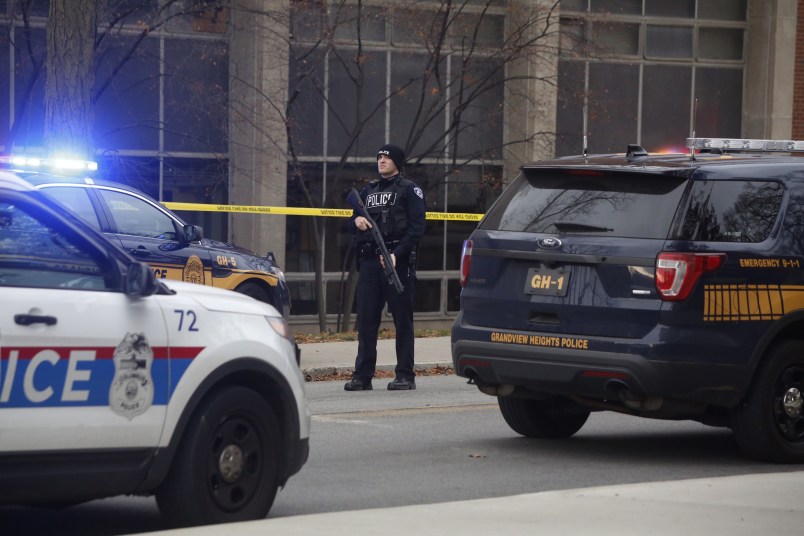COLUMBUS, Ohio (AP) — Ohio State University is beefing up its emergency alert system and streamlining the way officials communicate in a crisis after a November car-and-knife attack exposed some flaws in the text-message procedure.
Some campus contractors and visitors weren’t aware of automated campuswide “Buckeye Alerts” to seek shelter during the attack that wounded more than a dozen people, according to the report obtained by The Associated Press through an open records request.
Too much time passed between the 10 automated alerts, which were issued over a period of about seven hours, according to the report by the OSU Department of Public Safety. In addition, the initial alerts lacked specifics about the attack, according to the report.
The “After Action Review” also noted that the sheet-covered body of the attacker — shot dead by a police officer seconds after the attack began — was visible for hours, “potentially creating psychological trauma and panic.”
In addition, communication between safety personnel and top university officials was cumbersome and some outside police departments weren’t aware an “all-clear” message had been sent, the report said.
The report makes several recommendations for changes that the university is reviewing. Some have already been put in place.
“Public support for the law enforcement response has been gratifying, but we know there is always room for improvement,” Monica Moll, director of the university Department of Public Safety, said in a statement.
The Nov. 28 attack began when first-year Ohio State student Abdul Razak Ali Artan drove into a crowd outside a classroom building, then attacked people with a knife. Thirteen people were injured in the attack.
In a coincidence, a nearby building had been evacuated minutes earlier after reports of a gas leak. A university police officer assisting at the scene shot and killed the 18-year-old Artan almost immediately.
Authorities believe the attack by the Somalia-born Artan was partly inspired by a cleric killed in a U.S. drone strike in Yemen. An investigation continues.
Among other problems and recommended fixes:
— The university phone operator transferred many calls from worried parents and the media to an already overloaded 911 call center, limiting dispatchers’ “ability to focus on strategies/tactics” regarding the crisis. The report recommends the creation of a phone bank that could take such calls.
— Ohio State and City of Columbus police tactical teams had trouble communicating because their radios use different versions of encryption. The university plans to provide radios to its officers using the same encryption as Columbus.
— The alert system relies too heavily on text messages, which limits awareness of an emergency for people who haven’t signed up for alerts. Ohio State plans to increase the use of “pop-up” emergency messages on computers, insert alerts into digital signs around campus and let visitors sign up for alerts for specific times on campus, such as sporting events.
— University police weren’t trained to use a “fire alarm speaker system” to communicate with occupants in campus buildings. This meant that some people in buildings who weren’t getting Buckeye Alerts were unaware of the emergency and didn’t get updates. The report recommends training officers to use that speaker system and installing equipment allowing dispatchers to access the speakers remotely.
— To deal with “cumbersome” communication problems that developed between safety and senior academic officials, all top administrators will be relocated to the hall housing the university’s Department of Public Safety in an emergency.
— The university has purchased equipment that would shield a body from onlookers while letting an investigation continue.
— Some students, faculty and staff don’t know what to do in an emergency. The report recommends increasing opportunities around campus for learning the “Run, Hide, Fight” system for active-shooter situations. The report also recommends making sure the university’s Department of Public Safety has enough employees to boost emergency prevention and preparedness initiatives.
— Officials will look at ways to make initial alerts less generic and continue to support dispatchers sending those initial alerts but will also allow emergency operations officials to take over responsibility for sending alerts as soon as possible.
— Policies will be developed for instructing campus bus drivers on what to do with passengers when “shelter in place” alerts go out.
— Only armed officers will be used to search inside the so-called hot zone after concerns arose about using unarmed security personnel in building-to-building searches.
— An effort will be made to sign up more outside police agencies for alerts to avoid the problem of some agencies not getting the “all clear” alert.
___
Andrew Welsh-Huggins can be reached on Twitter at https://twitter.com/awhcolumbus. His work can be found at http://bigstory.ap.org/content/andrew-welsh-huggins
Copyright 2017 The Associated Press. All rights reserved. This material may not be published, broadcast, rewritten or redistributed.






